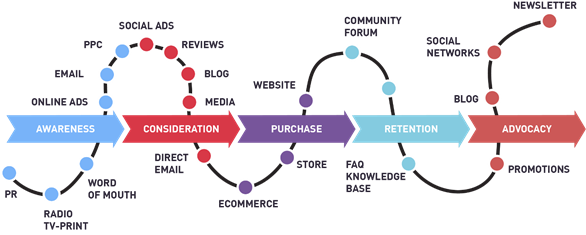DECIPHERING: How do Consumers Make Purchase Decisions?

Background
Suppose you are looking for a product on a particular website. As soon as you commence on the journey of making; the first search for a product, fidgeting on the idea to either buy it or not, and finally purchasing it, you are targeted or tempted by various marketing strategies through; various channels to buy the product.
You may start seeing the ads for the particular product on social media websites, on the side of various web pages, receive promotional emails, etc. This entire experience through these different channels that you interact with; will be referred to as touchpoints.

So, to sum up, whenever you provide an interest/signal to a platform that you are going to purchase a certain product, you may interact with these touchpoints mentioned above.
The job of a marketing team of a particular company is to utilize the marketing budget in a way that they get the maximum return on the marketing spend, i.e. to ensure that you buy their product.
So to achieve this, the marketing team uses a technique called Attribution.
What is Attribution?
Attribution is also known as Multi-Touch Attribution. Moreover, it’s an identification that walks you through of a set of user actions/events/touchpoints that drive a certain outcome or result and the assignment of value to each of those events/touchpoints.
Why is Attribution Important?
The main aim of marketing attribution is to quantify the influence of various touchpoints on the desired outcome and optimize their contribution to the user journey to maximize the return on marketing spend.
How does Attribution Work?
Assume; you had shown an interest in buying sneakers on Amazon. You receive the email tempting you to make the purchase, and finally, after some deliberation, you click on it and make the purchase. In a simple scenario, the marketing team will attribute your purchase to this email, i.e. they will feel that the email channel is what caused the purchase. They will think that there is a causal relationship between the targeted email and the purchase decision.
Suppose this occurrence is replicated across tens of thousands of users. The marketing team feels that email has the best conversion when compared to other channels. They start allocating more budget to it. They spend money on aesthetic email creatives, hire better designers, send more emails as they feel email is the primary driver.
But, after a month, you notice that the conversion is reducing. People are not interacting with the email. Alas! The marketing team has wasted the budget on a channel that they thought was causing the purchases.
Where did the Marketing Team go Wrong?
Attribution models are not causal, signifying that they give the credit of a transaction to a channel that may not necessarily cause that transaction. So, it was not only the emails that were causing the transactions; but there might have been another important touchpoint/touchpoints that were actually driving the purchase.
Understanding Causal Inference
The main goal of the marketing team is to use the attribution model to infer causality, and as we have discussed, they are not necessarily doing so. We need Causal Inference to truly understand the process of cause and effect of our marketing channels. Causal Inference deals with the counterfactual; it is imaginative and retrospective. Causal inference will instead help us understand what would have happened in the absence of a marketing channel.
Ta-Da!! Enters Incrementality. (Incrementality waiting the entire time to make its entrance in the blog)
What is Incrementality?
Incrementality is the process of identifying an interaction that caused a customer to do a certain transaction.
In fact, it finds the interaction that, in its absence, a transaction would not have occurred. Therefore, incrementality is the art of finding causal relationships in the data.
It is tricky to quantify the inherent relationships among touchpoints, so I have dedicated part 2 to discuss various strategies that are used to measure incrementality and how a marketing team can better distribute its budget across marketing channels.